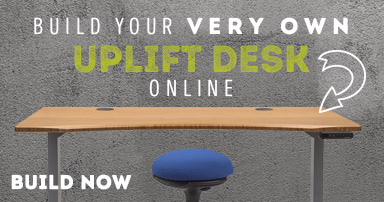Here I Sit: A Quick Guide to Good Ergonomic Posture
Posted by Tyler Reinhardt on May 26th 2017

It’s always a little jarring when you’re at the office just typing away the day and all of a sudden you hear a stream of expletives followed by an “OH, GOD WHY?!?!?” Yup. Your generic hypothetical coworker just reaped the results of months of bad posture. We’ll call him Steve. Steve is now clutching his wrist and/or forearm in immense pain. He will likely be out tomorrow for an appointment with his family physician. You don’t want to be like Steve. Being like Steve hurts physically. Instead, you want to be like you. The you that has good posture and utilizes proper support when sitting, mousing, or anything really. How do you become this version of you? We have a few tips to keep your work habits as ergonomic as possible.
One of Steve’s shortcomings was probably his posture. We’re all guilty of slouching or slumping from time to time but it’s not great for your body. You’ll want to give your posture a check every now and then just to avoid some inconvenient shoulder and back issues. To check your posture you’ll want to sit as close as possible to your desk and have your upper arms parallel to your spine. Then rest your hands on the work surface. Check to see if your elbows are at a 90 degree angle. If not, your chair is probably too high or low. Just adjust the height until you get the desired angle at your elbow. The 90 degree angle is also what you’re looking for in your legs. They should be 90 degrees at the knee. Do your best to maintain this sitting position as much as possible and if you feel yourself slouching or falling out of position, try standing up and taking a break for a couple of minutes.
After exploring posture, there are a couple of other things to be mindful of if you need to sit for a while. While riding high is generally considered a good thing, it’s not great for long hours of office work. Sitting too high can cause ankle swelling and loss of circulation. Most people are good with a seat height of 16 to 21 inches from the seat to the floor. If you want to test your sitting height, just slide a couple of fingers under your thigh at the front edge of the chair. If you can do so without issue, you’re golden. If you have less than a finger’s width of space between the chair and your thigh, you’re going to want to go shorter. If you can’t adjust the height of your seat for whatever reason, you should consider a foot stool or foot rest to make up the height difference. Your feet and ankles will thank you.
If you have more than a couple of fingers worth of space between your thigh and the chair, congratulations, you’re a bit tall for your seat. The best way to fix this is with a
height adjustable desk like the UPLIFT or a standing desk converter. This will take some strain off of your neck and back.
There are a couple of other things your chair should be doing for you. Supporting your back for instance. What you’re looking for here is support angling just past 90 degrees or up to 90 degrees. The chair should also push your back forward just slightly. Ideally the backrest of your chair would typically be between 12” and 19” with lower back support. The chair should also have some degree of arm rest adjustment. You’ll want to adjust the armrest to a point where your shoulders are just ever so slightly lifted. This takes strain off of your shoulders and supports your elbows.
Now back to Steve. While Steve will probably be coming into work tomorrow all battered and broken, you my friend will be coming in as productive as always. Because you’ve now read all the ways to avoid being like Steve. And if you ever have any questions about products to achieve optimal ergonomic excellence, feel free to give us a call at 800-531-3746 or use our
contact page.




